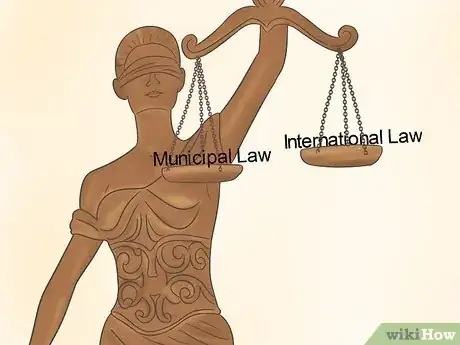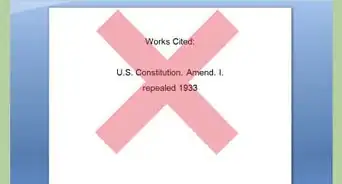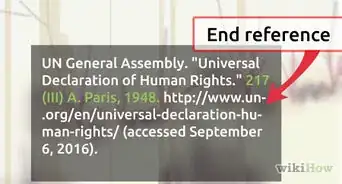This article was co-authored by Clinton M. Sandvick, JD, PhD. Clinton M. Sandvick worked as a civil litigator in California for over 7 years. He received his JD from the University of Wisconsin-Madison in 1998 and his PhD in American History from the University of Oregon in 2013.
There are 18 references cited in this article, which can be found at the bottom of the page.
wikiHow marks an article as reader-approved once it receives enough positive feedback. In this case, 85% of readers who voted found the article helpful, earning it our reader-approved status.
This article has been viewed 103,249 times.
International law, a term coined around 1800 by philosopher Jeremy Bentham[1] , refers to the body of legal decisions, rules, and customs that regulate the discourse between nations (e.g., human rights, military intervention, and global concerns such as climate change). Conversely, municipal law governs the actions of individuals and commercial entities within the borders of sovereign states (e.g., civil codes and criminal statutes).
Steps
Reviewing the Basics of International Law
-
1Understand the concept of public international law. When questions and conflicts arise in the relationships between sovereign nations, they are solved under the rules of public international law. This body of law consists of the treaties and legal decisions interpreting those treaties.[2]
- International law assumes that all the parties, as sovereign states, are equals.
- Conflicts arising under public international law can be settled either through diplomatic negotiations or in the International Court of Justice. This is the court of the United Nations. Fifteen judges, elected by the UN General Assembly, use international legal precedent to issue advisory opinions and solve legal disputes between governments.
- The International Court of Justice has jurisdiction in two types of cases. The first is where the two countries agree to submit the conflict to the court. The second is when a treaty specifies the court as the legal authority over disputes.
-
2Differentiate private international law from public. When citizens of different states have a legal dispute, there is often a question about what law applies. This choice of law question in civil issues, ranging from contracts to family law, is discussed in the Hague Conference on Private International Law.[3]
- In general, courts will first defer to any contract or agreement clauses that identify what courts will have jurisdiction.[4] In the absence of explicit choice of law language, the court will look to the overall circumstances of the contract, the behavior of the parties in creating the contract (called parol evidence[5] ) and if the parties can agree on jurisdiction.
Advertisement -
3
Examining the Precepts of Municipal Law
-
1Define municipal law. In common usage, especially in the United States, municipal or municipality, refers to a city or town. However, in the realm of international law, municipal refers to any sovereign entity, including countries, states, counties, provinces, cities, and towns. In short, municipal refers to the internal law of a sovereign government.[9]
-
2Familiarize yourself with the basics of municipal law. There are two primary forms of municipal, or domestic, law. The first is civil law, composed of the statutory law and regulations to administer those laws.[10] Statutes are passed either by the legislative bodies of the state or by popular vote. Domestic law is also formed by the common law, which is law handed down by the lower and upper courts of the country.[11]
- Common types of municipal law are criminal statutes, traffic laws, and government regulations. Basically, municipal law regulates the relationship of citizens with the government.
-
3Understand the enforcement mechanisms of municipal law. Civil and common law are enforced in very different ways. For example, law enforcement agencies, ranging from local police to the federal investigative branches, have jurisdiction over civil criminal statutes. On the other hand, most common law, often called judge-made law, is referred to during legal issues such as contract law or disputes between domestic businesses.[12] [13]
Distinguishing International and Municipal Law
-
1Look at how the laws were created. There are no international statutes. The United Nations agrees on conventions that member nations may choose to ratify and abide by, but there is no international governmental body. International law is created by treaty, by custom, and by agreements between nations. This is in stark contrast to the legislative process that creates the internal municipal laws of nations and states.
- International treaties are legally binding agreements between nations. In a nation like the United States, a treaty is an agreement ratified by Congress. Once it has been ratified, it holds the same status as federal legislation (i.e., statutes). Therefore, treaties can mean different things depending on the nation or international body discussing them.[14] An example of a treaty is the Treaty of Versailles, which was the peace settlement signed after World War I.[15]
- International agreements are usually less formal than treaties, although the international community often sees them on the same level as treaties. In the United States, an international agreement does not need to be ratified by Congress and they are only applicable in domestic law (i.e., they are not enforceable themselves). An example of an international agreement is the Kyoto Protocol, which sets international emissions reductions with the hope of curbing climate change.[16]
- International customs are created when a nation generally and consistently adheres to a certain practice due to a sense of legal obligation. They are not necessarily written down and are the least formal of all the sources of international law.[17]
-
2Study how the laws are enforced. There is no police agency with complete international jurisdiction. Even INTERPOL, the organization with 190 member countries, acts only as a coordination agency, passing information and training to municipal police forces.[18] When there is a dispute between nations, the international law is enforced through treaties, United Nations conventions, and the ICJ.
- In municipal law legal disputes, the case will be decided based either on the civil laws, in the form of statutes, or by the body of common law in the forum state.
-
3Study who the parties are and how they are affected. If the two sides in the legal dispute are sovereign nations, you can assume that international laws, enforcement methods, and dispute resolution will apply. Conversely, if both parties are citizens of the same nation, municipal law enforcement, court systems, and jurisdictional rules will be used to settle the dispute.
- When the citizenship is mixed, such as individuals of different countries or an individual in a dispute with a government of another sovereignty, the courts will look to any treaties, UN conventions, or contracts that may shed light on the jurisdiction before agreeing to accept jurisdiction.
Evaluating the Relationship Between International and Municipal Law
-
1Analyze the relationship from a "dualist" perspective. Many people in the international community see international and municipal law as two separate entities. These people would say each system regulates separate subject matters and each exists in its own sphere. They would say international law regulates the conduct of states and their interactions with one another. On the other hand, they would say municipal law regulates the conduct of people within a sovereign state.
- If you are a dualist, you would likely say the two barely interact at all. However, if they do, it would usually be when municipal law is recognizing and incorporating the rules of international law. Therefore, the national law would have supremacy over the international law. In case of conflict between international and municipal law, a national court would apply municipal law.[19]
-
2Scrutinize the connection from a "monist" perspective. Monists believe international law and municipal law are all part of one legal system. To them, both laws are based on the same premise, which is regulating the conduct of people and things.
- If you are a monist, international law will trump municipal law, even in national courts.[20]
-
3Determine how nations are required to to conform to international law. While nations are under a general obligation to follow international law, there is usually a great amount of leeway in how they choose to do so. Nations are generally free to decide how they incorporate international law into municipal law. While different nations handle this issue in different manners, the prevailing position seems to be dualist. Therefore, most nations require the formal integration of international law through the passage of some municipal law.[21]
-
4Assess how international law interacts with municipal law. In the international sphere, international law wins out over municipal law. However, municipal law is useful evidence of international customary law and general principles of law. In addition, international law often leaves questions to be answered by a nation's own laws. Therefore, if you found yourself in international court, you might use municipal law to help you decide whether there has been a breach of international law. An international court may even look to municipal law to help them interpret international law.
- In the municipal (i.e., national) sphere, the interaction is more difficult to assess. In general, less formal international agreements and customs are accepted and followed so long as there is no conflict with municipal law. If there is a conflict, municipal law will usually win. However, more formal treaties, so long as they are self-executing (i.e., operate within a nation automatically), are usually seen as being on par with municipal law. However, some nations take different views.[22]
References
- ↑ http://www.britannica.com/topic/international-law
- ↑ https://www.law.cornell.edu/wex/international_law
- ↑ https://www.hcch.net/en/home
- ↑ https://www.hcch.net/en/instruments/conventions/full-text/?cid=135
- ↑ https://www.law.cornell.edu/wex/parol_evidence_rule
- ↑ https://www.law.cornell.edu/wex/Customary_international_law
- ↑ https://treaties.un.org/doc/Publication/UNTS/Volume%201155/volume-1155-I-18232-English.pdf
- ↑ https://www.law.cornell.edu/wex/international_law
- ↑ http://www.academia.edu/5185447/INTERNATIONAL_LAW_VERSUS_MUNICIPAL_LAW_A_CASE_STUDY_OF_SIX_AFRICAN_COUNTRIES_THREE_OF_WHICH_ARE_MONIST_AND_THREE_OF_WHICH_ARE_DUALIST
- ↑ http://study.com/academy/lesson/administrative-regulatory-law-definition-example-cases.html
- ↑ http://www.merriam-webster.com/dictionary/common%20law
- ↑ http://www.ncsl.org/research/state-tribal-institute/jurisdiction-and-law-enforcement-overview.aspx
- ↑ https://onlinelaw.wustl.edu/blog/common-law-vs-civil-law/
- ↑ https://www.loc.gov/rr/main/govdocsguide/TreatyDefinition.html
- ↑ http://www.historylearningsite.co.uk/modern-world-history-1918-to-1980/the-treaty-of-versailles/
- ↑ http://unfccc.int/kyoto_protocol/items/2830.php
- ↑ https://www.law.cornell.edu/wex/customary_international_law
- ↑ http://www.interpol.int/About-INTERPOL/Overview
- ↑ https://sites.google.com/site/walidabdulrahim/home/my-studies-in-english/state-responsibility
- ↑ https://sites.google.com/site/walidabdulrahim/home/my-studies-in-english/state-responsibility
- ↑ https://sites.google.com/site/walidabdulrahim/home/my-studies-in-english/state-responsibility
- ↑ https://sites.google.com/site/walidabdulrahim/home/my-studies-in-english/state-responsibility













-Step-9-Version-2.webp)




-Step-13-Version-3.webp)






-Step-13.webp)










-Step-9-Version-2.webp)





































